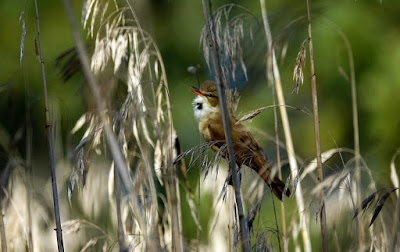The diminutive Reed Warbler, or more correctly, Australian Reed Warbler, has an impressive call for its size. Recently I heard my first one for this season at Bellbird Park wetlands in Drouin. The first call of the Reed Warbler is always a sign of the arrival of spring. Often described as a, “Sweet and melodious warble with rich, flute-like notes”, others say it is a, “Loud, clamorous declaration of territory”.
 |
| Reed Warblers can be hard to see sometimes |
Our Reed Warblers are migrants from the northern parts of Australia and perhaps the islands to the north. They arrive around late winter to early spring to select their favourite patch of reed bed and establish their breeding territories. It is believed that climate change is altering the migratory regimes of Reed Warblers and similar other species that regularly migrate between their breeding and non-breeding grounds.
 |
| Harbinger of spring |
The Reed Warbler builds a deep, cup-shaped nest, woven into several strands of reeds. A clever ‘architectural feature’ of the Reed Warblers nest is the slightly in-turned narrow opening, thought to be a means of preventing the eggs from rolling out when the wind bends the reeds from side to side. Some pairs apparently build two nests but only use one for incubation.
 |
| Sometimes secretive and hard to photograph amongst the reeds |
Their diet of insects, spiders and sometimes molluscs and seeds is obtained mostly from among the reeds and nearby mudflats. The species is very widespread – almost anywhere there is a freshwater or brackish reedbed. The bird is a little vulnerable to loss of habitat due to clearing, draining and altering of wetlands.
 |
| Ideal Reed Warbler habitat: Left- Amberly Estate, Right- McNeilly Wetlands |
The fringes of water bodies in Drouin at Bellbird Park, McNeilly wetlands, Crystal Waters, Amberly Estate, Alex Goudie Park and others, even ‘Froggy Hollow’ in Civic Park, are always good for spotting, or at least hearing a Reed Warbler.
No comments:
Post a Comment